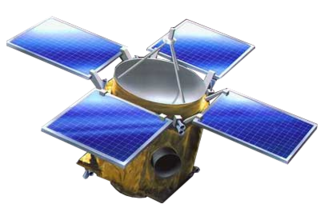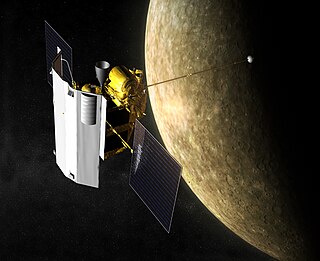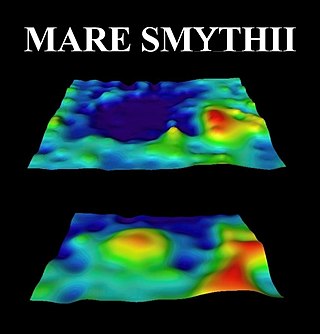
Near Earth Asteroid Rendezvous – Shoemaker, renamed after its 1996 launch in honor of planetary scientist Eugene Shoemaker, was a robotic space probe designed by the Johns Hopkins University Applied Physics Laboratory for NASA to study the near-Earth asteroid Eros from close orbit over a period of a year. It was the first spacecraft to orbit an asteroid and land on it successfully. In February 2000, the mission closed in on the asteroid and orbited it. On February 12, 2001, Shoemaker touched down on the asteroid and was terminated just over two weeks later.

A gravity assist, gravity assist maneuver, swing-by, or generally a gravitational slingshot in orbital mechanics, is a type of spaceflight flyby which makes use of the relative movement and gravity of a planet or other astronomical object to alter the path and speed of a spacecraft, typically to save propellant and reduce expense.
In physics, there are four observed fundamental interactions that form the basis of all known interactions in nature: gravitational, electromagnetic, strong nuclear, and weak nuclear forces. Some speculative theories have proposed a fifth force to explain various anomalous observations that do not fit existing theories. The characteristics of this fifth force depend on the hypothesis being advanced. Many postulate a force roughly the strength of gravity with a range of anywhere from less than a millimeter to cosmological scales. Another proposal is a new weak force mediated by W′ and Z′ bosons.

MESSENGER was a NASA robotic space probe that orbited the planet Mercury between 2011 and 2015, studying Mercury's chemical composition, geology, and magnetic field. The name is a backronym for "Mercury Surface, Space Environment, Geochemistry, and Ranging", and a reference to the messenger god Mercury from Roman mythology.

In astronomy, astrophysics and geophysics, a mass concentration is a region of a planet's or moon's crust that contains a large positive gravity anomaly. In general, the word "mascon" can be used as a noun to refer to an excess distribution of mass on or beneath the surface of an astronomical body, such as is found around Hawaii on Earth. However, this term is most often used to describe a geologic structure that has a positive gravitational anomaly associated with a feature that might otherwise have been expected to have a negative anomaly, such as the "mascon basins" on the Moon.

The equivalence principle is the hypothesis that the observed equivalence of gravitational and inertial mass is a consequence of nature. The weak form, known for centuries, relates to masses of any composition in free fall taking the same trajectories and landing at identical times. The extended form by Albert Einstein requires special relativity to also hold in free fall and requires the weak equivalence to be valid everywhere. This form was a critical input for the development of the theory of general relativity. The strong form requires Einstein's form to work for stellar objects. Highly precise experimental tests of the principle limit possible deviations from equivalence to be very small.
The Pioneer anomaly, or Pioneer effect, was the observed deviation from predicted accelerations of the Pioneer 10 and Pioneer 11 spacecraft after they passed about 20 astronomical units (3×109 km; 2×109 mi) on their trajectories out of the Solar System. The apparent anomaly was a matter of much interest for many years but has been subsequently explained by anisotropic radiation pressure caused by the spacecraft's heat loss.
The Lambda-CDM, Lambda cold dark matter, or ΛCDM model is a mathematical model of the Big Bang theory with three major components:
- a cosmological constant denoted by lambda (Λ) associated with dark energy
- the postulated cold dark matter denoted by CDM
- ordinary matter
Redshift-space distortions are an effect in observational cosmology where the spatial distribution of galaxies appears squashed and distorted when their positions are plotted as a function of their redshift rather than as a function of their distance. The effect is due to the peculiar velocities of the galaxies causing a Doppler shift in addition to the redshift caused by the cosmological expansion.

A millisecond pulsar (MSP) is a pulsar with a rotational period less than about 10 milliseconds. Millisecond pulsars have been detected in radio, X-ray, and gamma ray portions of the electromagnetic spectrum. The leading hypothesis for the origin of millisecond pulsars is that they are old, rapidly rotating neutron stars that have been spun up or "recycled" through accretion of matter from a companion star in a close binary system. For this reason, millisecond pulsars are sometimes called recycled pulsars.

Any planet is an extremely faint light source compared to its parent star. For example, a star like the Sun is about a billion times as bright as the reflected light from any of the planets orbiting it. In addition to the intrinsic difficulty of detecting such a faint light source, the light from the parent star causes a glare that washes it out. For those reasons, very few of the exoplanets reported as of January 2024 have been observed directly, with even fewer being resolved from their host star.

Doppler spectroscopy is an indirect method for finding extrasolar planets and brown dwarfs from radial-velocity measurements via observation of Doppler shifts in the spectrum of the planet's parent star. As of November 2022, about 19.5% of known extrasolar planets have been discovered using Doppler spectroscopy.
In classical theories of gravitation, the changes in a gravitational field propagate. A change in the distribution of energy and momentum of matter results in subsequent alteration, at a distance, of the gravitational field which it produces. In the relativistic sense, the "speed of gravity" refers to the speed of a gravitational wave, which, as predicted by general relativity and confirmed by observation of the GW170817 neutron star merger, is equal to the speed of light (c).
Vyacheslav Gennadievich Turyshev is a Russian physicist now working in the US at the NASA Jet Propulsion Laboratory (JPL). He is known for his investigations of the Pioneer anomaly, affecting Pioneer 10 and Pioneer 11 spacecraft, and for his attempt to recover early data of the Pioneer spacecraft to shed light on such a phenomenon.
Frame-dragging is an effect on spacetime, predicted by Albert Einstein's general theory of relativity, that is due to non-static stationary distributions of mass–energy. A stationary field is one that is in a steady state, but the masses causing that field may be non-static — rotating, for instance. More generally, the subject that deals with the effects caused by mass–energy currents is known as gravitoelectromagnetism, which is analogous to the magnetism of classical electromagnetism.

486958 Arrokoth (provisional designation 2014 MU69; formerly nicknamed Ultima Thule) is a trans-Neptunian object located in the Kuiper belt. Arrokoth became the farthest and most primitive object in the Solar System visited by a spacecraft when the NASA space probe New Horizons conducted a flyby on 1 January 2019. Arrokoth is a contact binary 36 km (22 mi) long, composed of two planetesimals 21 and 15 km (13 and 9 mi) across, that are joined along their major axes. With an orbital period of about 298 years and a low orbital inclination and eccentricity, Arrokoth is classified as a cold classical Kuiper belt object.

The gravity of Mars is a natural phenomenon, due to the law of gravity, or gravitation, by which all things with mass around the planet Mars are brought towards it. It is weaker than Earth's gravity due to the planet's smaller mass. The average gravitational acceleration on Mars is 3.72076 m/s2 and it varies.

Long Range Reconnaissance Imager (LORRI) is a telescope aboard the New Horizons spacecraft for imaging. LORRI has been used to image Jupiter, its moons, Pluto and its moons, and Arrokoth since its launch in 2006. LORRI is a reflecting telescope of Ritchey-Chrétien design, and it has a main mirror diameter of 208 mm across. LORRI has a narrow field of view, less than a third of a degree. Images are taken with a CCD capturing data with 1024 × 1024 pixels. LORRI is a telescopic panchromatic camera integrated with the New Horizons spacecraft, and it is one of seven major science instruments on the probe. LORRI does not have any moving parts and is pointed by moving the entire New Horizons spacecraft.

REX or Radio Science Experiment is an experiment on the New Horizons space probe to measure properties of the atmosphere of Pluto during the 2015 flyby.














